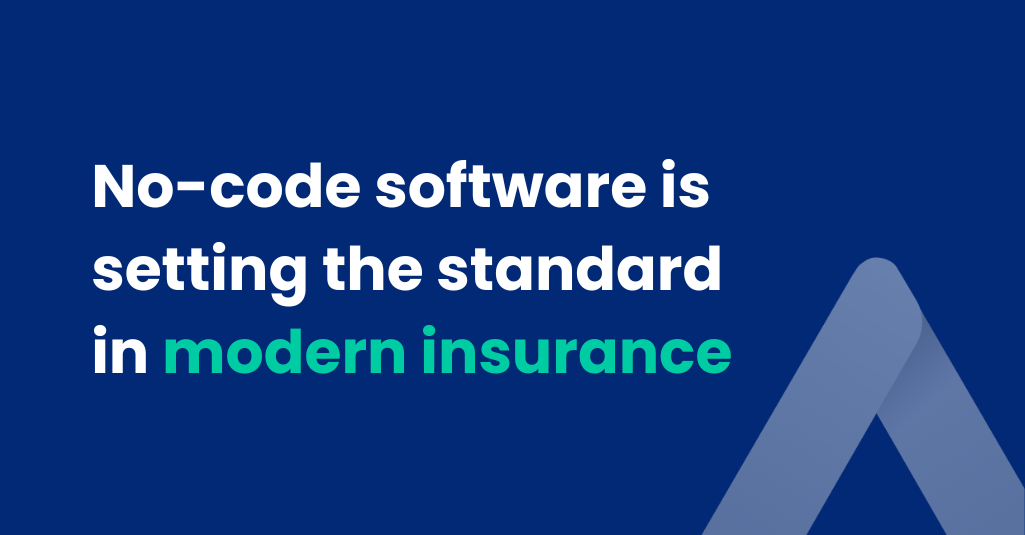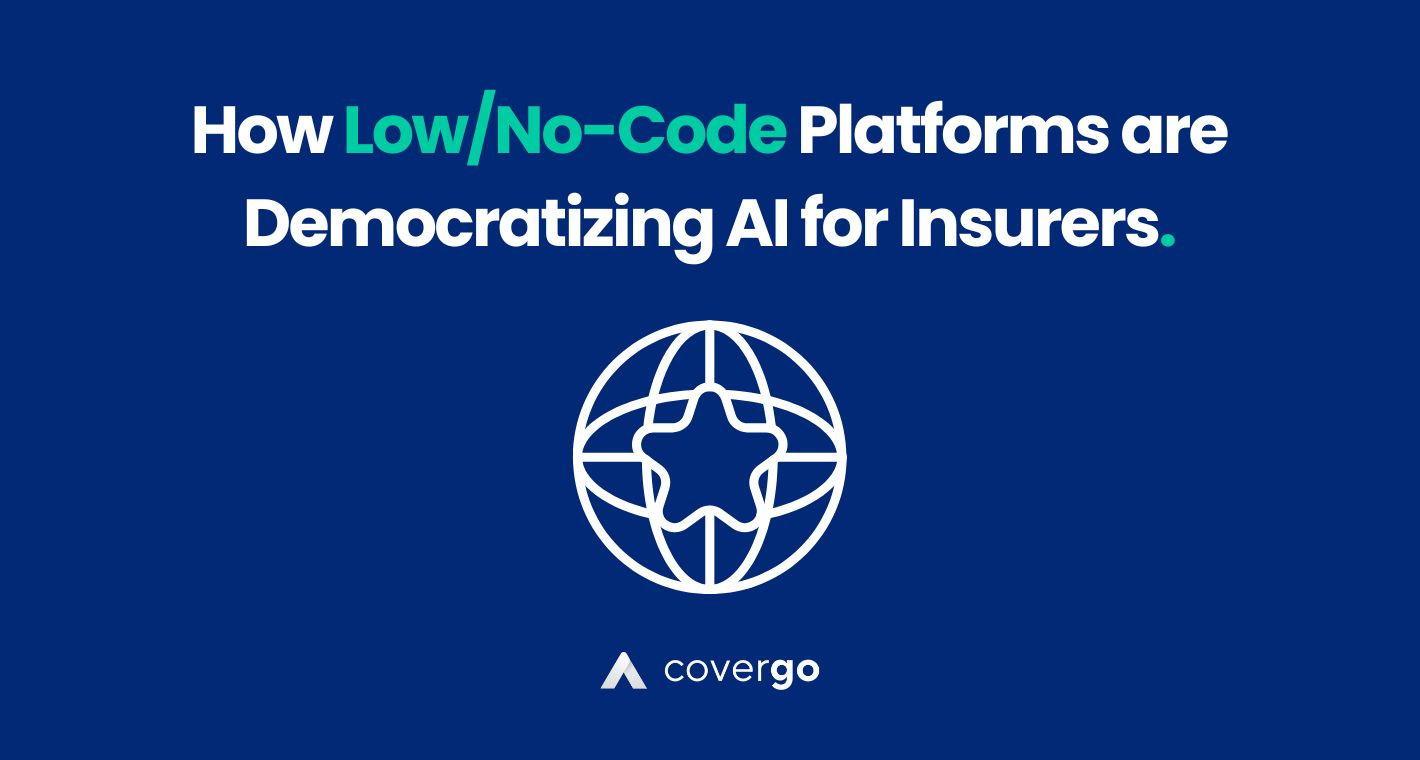Key takeaways:
- Efficiency Boost: No-code software reduces reliance on developers, saving time and money by enabling non-technical users to create solutions independently.
- Cost Savings: By requiring fewer developers and reducing training costs, organizations can allocate resources more efficiently and address technical challenges effectively.
- Enhanced Collaboration: No-code tools foster collaboration among stakeholders, leading to diverse perspectives and improved product quality and usability.
- Speed to Market: In the insurance industry, no-code software accelerates product innovation, automates processes, and facilitates collaboration across the value chain.
In this article, we’ll explain what no-code software is and how its benefits are taking the insurance industry by storm.
What is no-code software?
In simple terms, no-code software doesn’t require coding for its development. Users can construct applications through simple drag-and-drop functionality, even when not armed with technical knowledge on programming and software. In other words, the tool is specifically targeted toward non-professional developers – while code sits beneath the platform and ensures its proper running, knowledge of coding is not essential for utilizing it.
This reduces organizational reliance on programmers, as any business user has the ability to make use of this drag-and-drop functionality, saving money and increasing efficiency and coordination across cross-functional teams. With the rapid digitization of the world economy, the benefits of no-code software tools are applicable to a vast number of industries today.
In the case of insurance companies, no-code tools can be very effective in enabling businesses to accelerate product innovation in a cost-effective manner. Therefore, leaders will be able to meet rapidly evolving customer demands and increase the satisfaction of their customers and ecosystem partners.
The key benefits of no-code software
The most valuable benefit of no-code technology is the reduction in the time needed to complete a task. Time is everything in business, and saving hours on business-critical tasks that are most amenable to no-code tools means more time to allocate to large improvement projects and other important initiatives that will take your organization to the next level.
No-code drag-and-drop functionality drastically cuts down the time needed for tasks, given that it becomes unnecessary to rely on a developer and the limitations of their schedule. Instead of competing for their precious time and resources, non-technical business users are able to leverage no-code tools to come up with new solutions directly out of the box.
A simple yet increasingly powerful example of this can be found in the face a corporation displays to the world: its website. In years gone by, excessive front-end development was needed to create beautiful websites that users would want to linger on.
However, with the arrival of user-friendly, no-code website builders such as Wix, the reliance on front-end developers in web design has disappeared. Using Wix, you are able to use drag-and-drop tooling to build websites in a fraction of the time, and better still, any integrations that may be needed (such as a payments processor in order to sell products directly on your site) are included too, supercharging go-to-market.
Reducing reliance on developers brings with it another major advantage in the form of cost savings. Developers tend to command higher salaries than equally tenured non-technical workers and are costly for companies to train and retain in increasingly competitive markets for technical talent.
Through the use of no-code software, fewer developers are required; instead, they can be more selectively deployed to the most cutting-edge technical problems companies are attempting to solve. Problems for which no-code does not yet have the answer.
This entails greater efficiency. As no-code allows a company to lean on non-technical business users, applications and products are built through the help of more people. This significantly reduces workflow bottlenecks, given that a small group of people are no longer the only resources with the expertise to contribute.
The resulting flexibility in resource allocation means that each project can be completed more efficiently, allowing the next initiative to reach the agenda that much faster. It also reduces the likelihood of employee burnout, as the workload is spread over evenly across the organization.
Before no-code software became popular, anything code related tended to be built in silos, since the technical knowledge base required to complete these projects was incredibly large. As explained above, because tools have become easier to use through no-code technology, more people are now involved in building digital products.
This ensures a diversity of perspectives spanning all stakeholders in the organization, which tends to increase the quality of the end product, as well as usability by the end user, given they are also less likely to be so technically inclined.
How no-code software can be leveraged in the insurance industry
Let’s take a deep dive into how no-code tools can be used to improve and simplify existing workflows and processes in insurance.
Increased speed to market
Modern insurance needs are only becoming more complex as the world continues to innovate and digitize. With an abundance of sensitive information stored in the cloud, cyber risk has increased exponentially in recent years, and cyber insurance products must keep pace in order to adequately safeguard against malicious actors.
Even among standard personal insurance lines, such as investment-linked or annuity life insurance policies, customer needs are rapidly increasing and evolving, and product innovation must keep pace. However, the rate of product launches expected by the market has become incredibly high, and legacy core systems simply cannot keep up, where product lifecycles last months.
With no-code insurance technology, it’s now possible to design products in days, thanks to drag-and-drop functionality built upon key insurance policy building blocks such as plan, type, benefit, and deductible objects to name a few. Using APIs, products can be seamlessly connected to multiple channels of distribution, supercharging go-to-market.
This empowers insurers, brokers and MGAs to meet customer needs quicker and more completely, increasing customer satisfaction. Early adopters of no-code software in insurance are winning these product battles across geographies, industries, and lines of business, providing them with a powerful competitive advantage.
Automation for MGAs
With no-code software, building a system with thousands of brokers and/or suppliers is achievable, where each is customized with its own set of workflow rules. This reduces a significant amount of time and cost for MGAs, thanks to the ability to automate larger parts of their processes as a result. The need to understand and design suitable processes each time an MGA is working with a new broker is eliminated, increasing the efficiency of operations dramatically and allowing an MGA to partner with more brokers and suppliers, increasing revenue.
Collaboration across the value chain
The ability to build complex insurance products in a matter of days makes collaboration between different stakeholders in the industry easier than ever. Given the lack of excessive coordination required between employees on each side as a result of the user-friendly product development experience when utilizing no-code technology, MGAs, carriers, and brokers can easily work together on meeting the needs of the end customer.
As a result of regular collaboration, processes on all sides become more efficient, as brokers have a better understanding of the products producers are able to underwrite, as well as their risk appetite and premium pricing. Thus, there are fewer surprises for all parties, especially for the customer as the initial quote received from the broker is more accurate.
Omni-channel digital distribution
No-code insurance platforms not only have the ability to expedite product development but most importantly can connect newly created products to a variety of digital distribution channels.
Through front-end application builders and API integrations, digital insurance products can be rolled out on insurance companies’ websites as well as on online aggregators and marketplaces, revolutionizing the quote, bind, and issue process flow and enabling straight-through processing for instant policy issuance.
Brokers and agents receive the complete view of the customer through bespoke front-end portals, enabling seamless cross-sales and renewals. Paper forms are no longer necessary and are easily digitizable across all policy lines, rapidly increasing the speed at which distributors operate.
Seamless policy and claims administration
In the past, policy and claims administration has tended to be an incredibly inefficient process requiring manual intervention by specialized teams of employees and siloed decision-making. With the propensity for paper forms to be filled out incorrectly, it was often a necessity for claims adjusters and renewal teams to track down these customers by email and phone.
Bottlenecks would constantly arise and persist, making for very inefficient systems of engagement. Legacy core policy administration systems would further slow employees down.
However, no-code insurance platforms can eliminate these pain points by automating policy and claims administration. Thanks to the digitization of paper forms from the very beginning of the customer journey, management of endorsements, renewals, and claims processing can be consolidated into a single view and integrated with your existing core system to ensure visibility on existing policies.
Get in touch with us today
CoverGo is the first fully configurable, modular, no-code insurance platform for rapid product launch and go-to-market, omni-channel distribution, and intelligent policy management. Powered by an unrivaled suite of insurance APIs, our platform enables out-of-the-box integration and the ability to automate all of your insurance processes.
If you’re an insurer seeking the transformational benefits of no-code software, look no further. Get in touch with our expert team today to learn how you can take your insurance business into the future.
FAQs
No-code software allows users to build applications without coding knowledge, utilizing drag-and-drop interfaces for quick development. This eliminates the need for professional developers and speeds up the creation process.
No-code software enables insurers to rapidly design and launch new products, automate processes for MGAs, facilitate collaboration across stakeholders, and establish omni-channel digital distribution for products, enhancing overall efficiency and customer satisfaction.
No-code tools promote collaboration by involving a wider range of stakeholders in product development. This diversity of perspectives results in higher-quality end products and improved usability, as decisions are informed by various viewpoints.
- How Low/No-Code Platforms are Democratizing AI for Insurers
- All of the ways AI is Transforming the Insurance M&A Industry.
- 10 Crucial Mistakes to Avoid When Filing an Insurance Claim
- 5 Important Tips That Will Make Filing Claims For Specialized Policies a Breeze
- Artificial Intelligence as The New Defender Against Insurance Fraud



